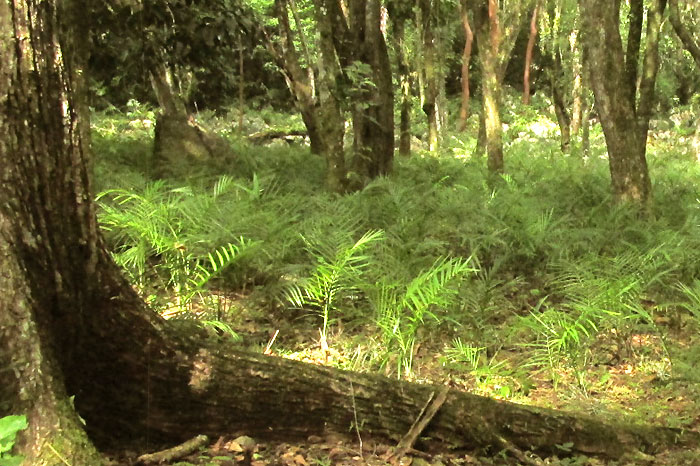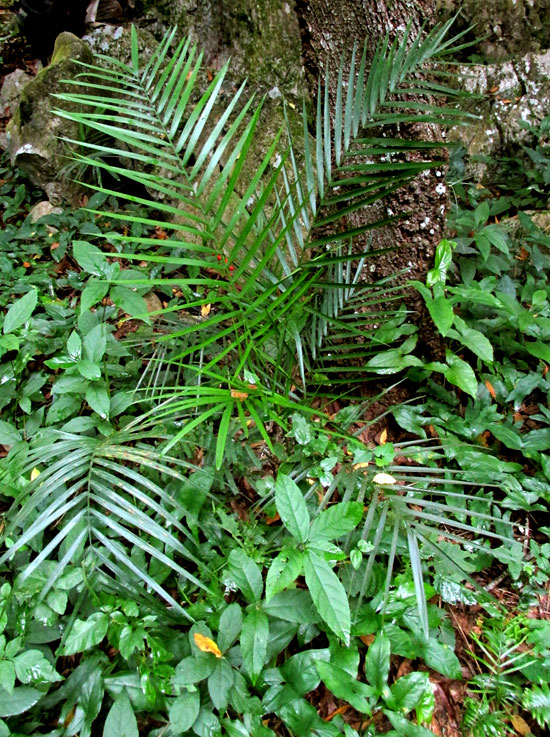Excerpts from Jim Conrad's
Naturalist Newsletter
entry from field notes dated October 7, 2022, taken about 3kms north of Gómez Farías, on the lower eastern slope of the Eastern Sierra Madres, El Cielo Biosphere Reserve, southern Tamaulipas state, MÉXICO; elevation about 300m (1000 ft), ± LAT. 23.04°N, LONG. -99.15°W
PARLOR PALM

In woodland along the road approaching the bottom of Cañón el Azteca, Aztec Canyon, about 3 kms north of the village of Gómez Farías, here and there all understory has been cleared away. Taller trees shade plots of various sizes -- seldom larger than a typical suburban North American house lot -- and local people have planted a dwarf palm species, as shown above. Here's a close-up of one of the plants:

That knee-high plant is mature, as indicated by the red fruits barely visible near the picture's center, and is not one of the planted palms, though it grew only about 3m (10ft) from a plantation's border. In the picture's lower, right corner, a young palm is just emerging, apparently as a wild plant. The palms shelter between two fin-like buttresses at the bottom of a tree trunk. Here's a closer look at the drupe-type fruits:


At the right you can see how large the single seed is, and how thin the red fleshy part.
Northerners who keep potted plants might recognize this as a "parlor palm." Parlor palm species belong to the big Palm Family genus (100+ species) Chamaedorea, all native to tropical and subtropical regions of Mexico, Central America and northern South America. The species are relatively small palms, living in shady forest understories.
Several species are grown in temperate climates as houseplants and, in warmer areas, garden plants. Also, fronds of certain species are collected from the forest, and grown commercially, to be sold internationally as attractive and long-lasting background components of floral arrangements of the kind often seen at weddings and funerals.
The most commercialized Chamaedorea species sold under the name Parlor Palm is Chamaedorea elegans, native to Mexico south to Honduras and El Salvador. However, in Mexico that species isn't known to occur as far north as Tamaulipas state, plus its frond segments generally are shorter, broader, and less numerous than the slender segments shown in our picture.
The only Chamaedorea species listed in the 1995 work by Alfonso Valiente-Banuet and others entitled "La Vegetación Selvática de la Región de Gómez Farías, Tamaulipas, México" -- forest vegetation of the Gómez Farías region -- is Chamaedorea radicalis. Also, the Periódico Oficial, the "official journal," of the state of Tamaulipas dated November 28, 2013 characterizes the cultivation and exploitation of Chamaedorea radicalis here in El Cielo Biosphere Reserve as providing the main income for a large percentage of the population -- "es la principal fuente de ingresos para gran porcentaje de la población de la RBEC." Finally, our plant's features appear to match perfectly those of pictures of Chamaedorea radicalis on the Internet.
Therefore, despite a number of Chamaedorea species being cultivated for commercialization, and there being no flora treating Mexican Chamaedorea species defining the differences between Chamaedorea radicalis and other Chamaedorea species, it seems certain that our pictures show CHAMAEDOREA RADICALIS, which in English often shares the name of Parlor Fern with several other species.
Chamaedorea radicalis is endemic just to northeastern Mexico -- the states of Nuevo León, San Luis Potosí, Hidalgo and here in Tamaulipas. It's described as growing mainly in moist oak forests up to 1000m in elevation (3300ft), though our woodland was too low in elevation to support oaks. Oaks do appear higher up.
Despite the species' limited natural distribution, and the fronds of wild plants still being harvested for sale abroad, the species isn't in danger of extinction, for it's grown in many northern nurseries for use as potted plants and in gardens in warmer areas. At the International Palm Society "Palm Talk" forum, it's described as "... one of the more widely grown of the genera as it's very attractive, is quite hardy to heat and cold, and drought tolerant when established, and it extends the range for an outside palm for many of us that get occasional freezes. It will take temps. down to about 22 F with no damage, and will survive much lower temps."
Still, our species isn't nearly as commercially successful as Chamaedorea elegans. One reason may be because it's something of a slow grower. B.A. Endress and others in a 2004 paper reported that Chamaedorea radicalis produces only about two new leaves each year. The University of Florida's "Chamaedorea Palm Production Guide" says that our Tamaulipas species "... was recently introduced to the interiorscape industry in some quantity, primarily by one Florida nurseryman." It adds that the species is still being evaluated, but that "results thus far look good under medium and low light levels indoors."
I think our Tamaulipas is every bit as attractive as Chamaedorea elegans, plus it's more tolerant to cold, so before long it well could be the most popular cultivated Chamaedorea species.